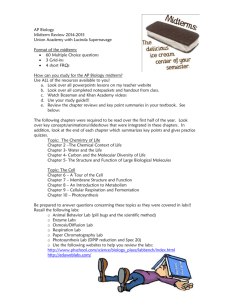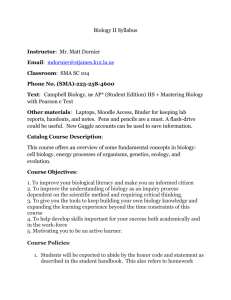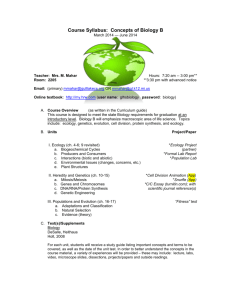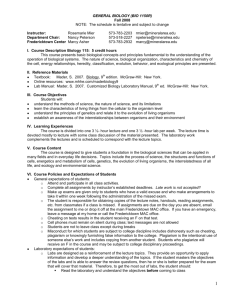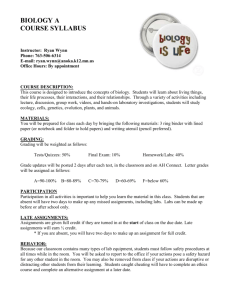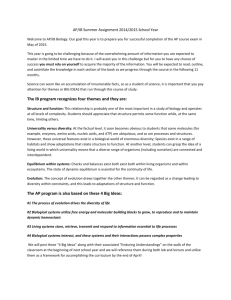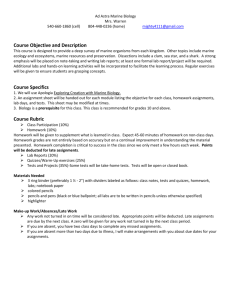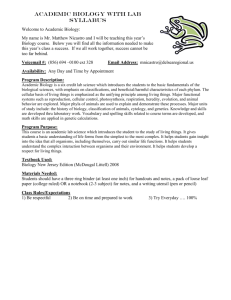File - Malone Biology
advertisement
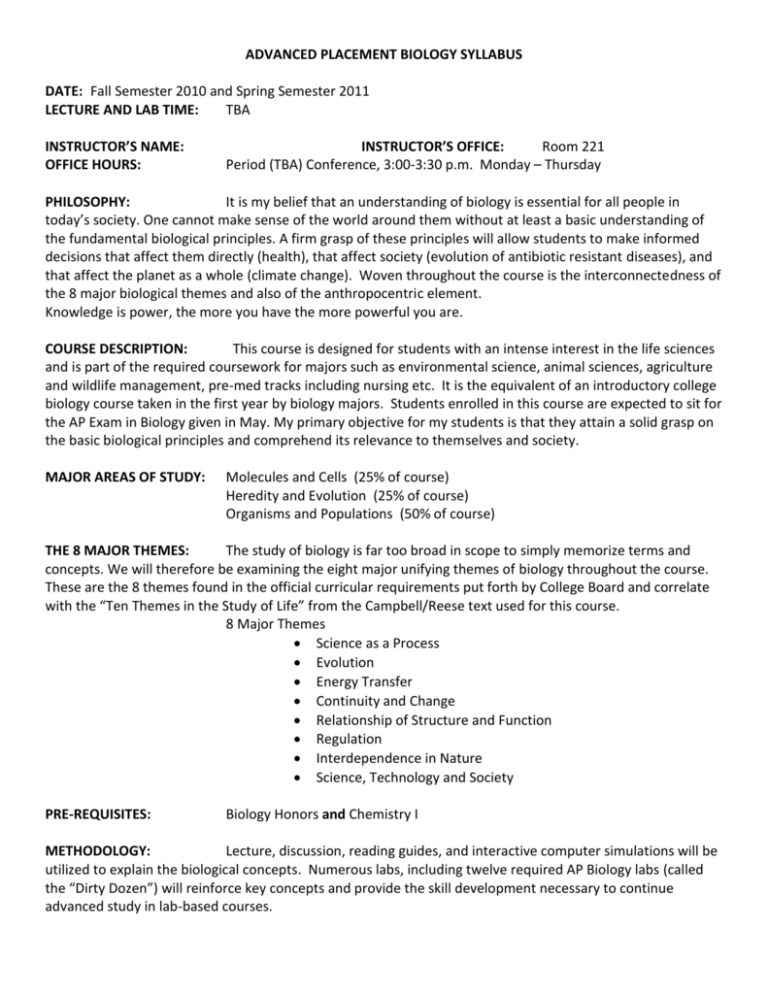
ADVANCED PLACEMENT BIOLOGY SYLLABUS DATE: Fall Semester 2010 and Spring Semester 2011 LECTURE AND LAB TIME: TBA INSTRUCTOR’S NAME: OFFICE HOURS: INSTRUCTOR’S OFFICE: Room 221 Period (TBA) Conference, 3:00-3:30 p.m. Monday – Thursday PHILOSOPHY: It is my belief that an understanding of biology is essential for all people in today’s society. One cannot make sense of the world around them without at least a basic understanding of the fundamental biological principles. A firm grasp of these principles will allow students to make informed decisions that affect them directly (health), that affect society (evolution of antibiotic resistant diseases), and that affect the planet as a whole (climate change). Woven throughout the course is the interconnectedness of the 8 major biological themes and also of the anthropocentric element. Knowledge is power, the more you have the more powerful you are. COURSE DESCRIPTION: This course is designed for students with an intense interest in the life sciences and is part of the required coursework for majors such as environmental science, animal sciences, agriculture and wildlife management, pre-med tracks including nursing etc. It is the equivalent of an introductory college biology course taken in the first year by biology majors. Students enrolled in this course are expected to sit for the AP Exam in Biology given in May. My primary objective for my students is that they attain a solid grasp on the basic biological principles and comprehend its relevance to themselves and society. MAJOR AREAS OF STUDY: Molecules and Cells (25% of course) Heredity and Evolution (25% of course) Organisms and Populations (50% of course) THE 8 MAJOR THEMES: The study of biology is far too broad in scope to simply memorize terms and concepts. We will therefore be examining the eight major unifying themes of biology throughout the course. These are the 8 themes found in the official curricular requirements put forth by College Board and correlate with the “Ten Themes in the Study of Life” from the Campbell/Reese text used for this course. 8 Major Themes Science as a Process Evolution Energy Transfer Continuity and Change Relationship of Structure and Function Regulation Interdependence in Nature Science, Technology and Society PRE-REQUISITES: Biology Honors and Chemistry I METHODOLOGY: Lecture, discussion, reading guides, and interactive computer simulations will be utilized to explain the biological concepts. Numerous labs, including twelve required AP Biology labs (called the “Dirty Dozen”) will reinforce key concepts and provide the skill development necessary to continue advanced study in lab-based courses. LABORATORY Hands on laboratory time is an important part of any science course. I cover all twelve of the labs in the AP Laboratory Manual for Students as well as integrating supplemental labs throughout the course. Labs make up 25% of this course so it is extremely important to attend every class. EVALUATION CRITERIA: Grades will be based on exams and quizzes, homework, lab reports and classwork. A weighted grading scale will be employed with the following break-down: Exams and quizzes Lab reports Classwork Homework Participation = = = = = 40% 20% 15% 15% 10% Grades will be assigned according to the following scale: 100% - 90% = A 89% - 80% = B 79% - 70% = C 69% - 60% = D *Exam grades may be curved at the instructor’s discretion. ABSENCE POLICY: This is a fast-paced course covering a great deal of material within a short time. To be successful on the AP exam and provide an experience commensurate with a college course, it will be necessary to maintain a rigorous schedule. Work done on the day of an absence results in a grade of zero until the work is made up. The student has 3 days to clear an absence and make-up the work. It is the student’s responsibility to: 1. Obtain missed lecture notes from another student. 2. Make-up missed labs and exams. 3. Obtain details about reading assignments and homework. TEXT: Biology, Campbell and Reece, 8th Edition Published by: Prentice-Hall Highly recommended but not mandatory: Purchase an AP review guide such as Cliff’s, from your local bookstore. Border’s on Providence Road has a wide variety of guides. In the past many students have regretted that they didn’t purchase a review book sooner. REQUIRED MATERIALS: Biology Lab Manual for Students (2001) o $18.00 at http://store.collegeboard.com/sto/productdetail.do?Itemkey=991461 Laboratory research notebook book (~$20.00) (ISBN 0-7167-3900-3) o USF Book Store or Grey’s Bookstore o http://www.whfreeman.com/newcatalog.aspx?disc=Chemistry&course =Lab+Notebooks&isbn=0716739003 o http://www.amazon.com/Laboratory-Notebook-W-H-FreemanCompany/dp/0716739003 scientific calculator 3-ring binder 5 tab dividers Highlighter planner AP BIOLOGY FALL 2008 SCHEDULE WITH COURSE CONTENT: Unit 1: Overview/Introductory Information Characteristics of Life Unifying Themes of Biology Classification of Organisms Reading assignments: Chapter 1, Chapter 25 pgs 496 – 501 Activities/Labs: Experimental Design Analysis: (1) analyze one of several experiments for the required elements of appropriate experimental design (2) Discuss your findings with the class Unit 2: Chemistry Atomic structure and bonding Properties of water In-organic compounds Properties of carbon Functional groups and organic compounds Enzyme properties and dynamics Reading assignments: Chapters 2 – 5 Activities/Labs: Properties of Water Buffer Lab Carbohydrate Identification Unit 3: Cellular Biology Developments in cell biology Microscopy techniques Organelles and structures Cell transport mechanisms Reading assignments: Chapters 6 and 7 Articles: My Cells are Your Cells Stem Cells Labs/Activities: Sketches of various cell types : bacteria, plants, fungi, protists, muscle cells, white blood cells (identify structures visible) Identifying Cells AP Lab 1: Diffusion and Osmosis Unit 4: Metabolism Bioenergetics Photosynthesis: Light dependent reaction Photosynthesis: Calvin Cycle Respiration: Glycolysis Respiration: Kreb’s Cycle Respiration: Oxidative Phosphorylation Reading assignments: Chapters 8 – 10 Labs/Activities: AP Lab 2: Enzyme Catalysis AP Lab 4: Plants and Pigments AP Lab 5: Cell Respiration Unit 5: Cell Reproduction Cell cycle and hormonal regulation Mitosis Meiosis Cell communication mechanisms Reading assignments: Chapters 11 – 13 Labs/Activities: AP Lab 3: Mitosis and Meiosis Unit 6: Genetics and Heredity Mendelian principles and inheritance Chromosomal theory and pedigree analysis Genetic Disorders Reading assignments: Chapters 14 and 15 Articles: Genetic Testing Building Genes from Scratch Labs/Activities: Fingerprint Analysis Photograph comparison: analyze parents/children based on phenotypic features present in high school photographs AP Lab 7: Genetics of Organisms December: Semester One Exam: cumulative exam covering Chapters 1 - 15 AP BIOLOGY SPRING 2009 SCHEDULE WITH COURSE CONTENT Unit 7: Molecular Biology DNA structure and replication RNA structures and types Protein Synthesis Reading assignments: Chapters 16 and 17 Labs/Activities: Discussion Topics including: (1) Historical developments in the discovery of DNA (2) DNA Structure (3) DNA Replication and Repair (4) RNA Structure and Types (5) Protein Synthesis (6) Mutations: Causes and Types Unit 8: DNA Technology Transgenic organisms Electrophoresis and DNA fingerprinting PCR and gene sequencing Transformation Reading assignments: Chapter 20 and 21 Article: The Human Genome Project Labs/Activities: AP Lab 6: Transformation AP Lab 6: Restriction Enzyme Cleavage of DNA Unit 9: Evolutionary Theory Historical perspective and Charles Darwin Micro-evolution and Hardy-Weinberg Theory Speciation mechanisms Macro-evolution Reading assignments: Chapters 22 – 24 Articles: Origins From Bones to Brains Labs/ Activities: Virtual Voyage using disk from Campbell-Reece Observations of variation in species AP Lab 8: Population Genetics Unit 10: Organisms and populations Prokaryotes and bacteria Protists and algae Fungi and slime molds Animals: invertebrates Animals: vertebrates Reading Assignment: Chapters 26 – 28 and 31 - 34 Labs/Activities: Collection, growth and identification of bacteria from school Observations of various selected protists (euglena, amoeba, paramecium) Mushroom and mold Lab Classification of invertebrate and vertebrate specimens AP Lab 10: Physiology of the Circulatory System Unit 11: Plant Structure and Function Classification of plants Structure and life cycle of bryophytes Structure and function of gymnosperms Structure and function of angiosperms Plant hormones and growth Reading assignments: Chapters 29 and 30, 35 – 39 Labs/Activities: Classification of various plant specimens (moss, liverworts, spruce, pine, carnations, lilies, etc.) AP Lab 9: Transpiration Unit 12: Ecology Ecosystem dynamics Biogeochemical cycles Populations and limiting factors Biomes Conservation and pollution Reading assignments: Chapters 50 -55 Labs/Activities: Water Cycle Lab AP Lab 11: Animal Behavior AP Lab 12: Dissolved Oxygen Field Study: (1) Obtain data on the abiotic factors of a Wetland, Upland or Coastal ecosystem (2) Collect specimens of flora and fauna (3) Classify the specimens collected (4) Compile a field report presenting the findings May : Review and prepare for the AP Exam in Biology All unit exams are written in the same format as the AP Exam Unit exams include challenging multiple choice questions as well as essay questions requiring extended constructed responses Review sessions are conducted in the evening so as not to disrupt the instructional time necessary to complete the units of study
